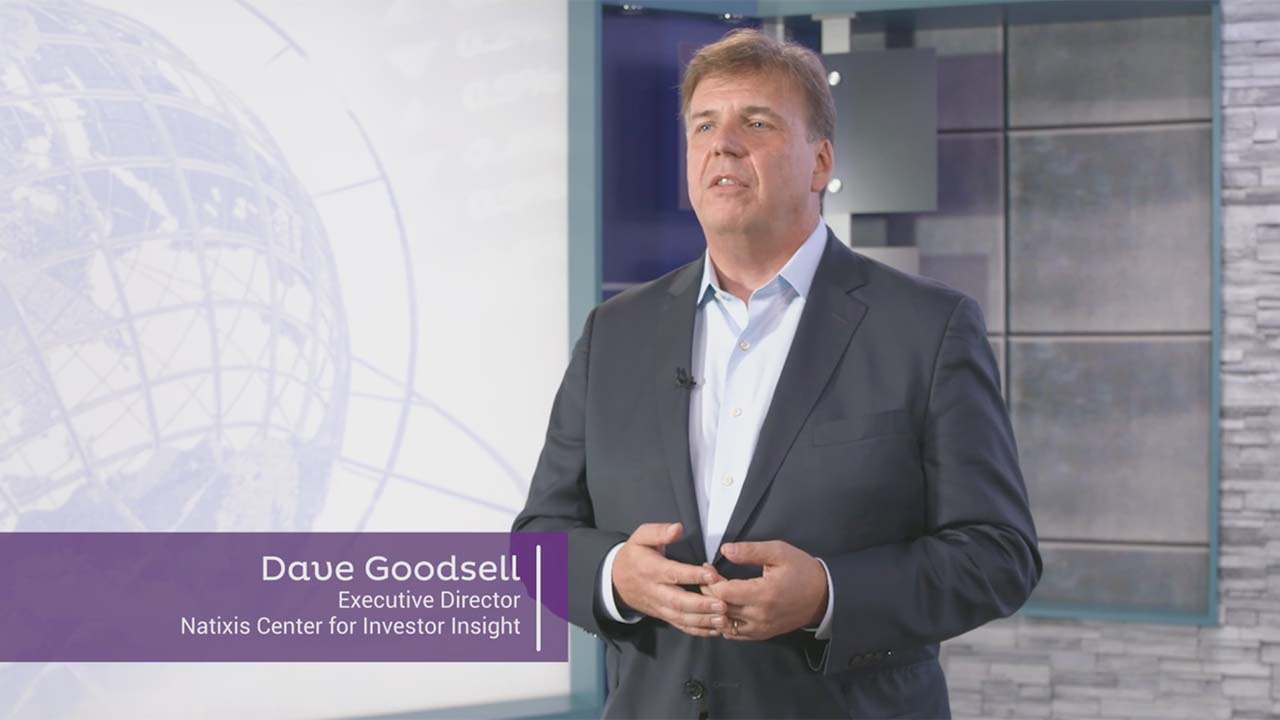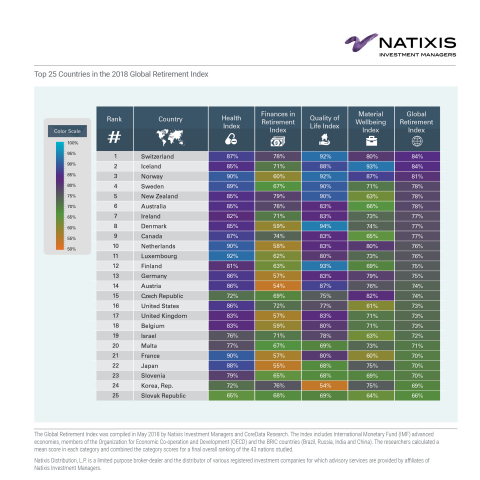TORONTO--(BUSINESS WIRE)--Canada rose two spots to No. 9 among 43 countries in the 2018 Global Retirement Index, released today by Natixis Investment Managers. The modest rise in Canada’s ranking is attributed to improving economic conditions and environmental factors. However, 10 years after the global financial crisis, Natixis points to a confluence of factors – ultra-low interest rates, growing levels of public debt, aging populations and human longevity – as indicators for the ongoing sustainability of retirement systems in Canada and around the world.
“Global retirement security is facing a multi-dimensional problem, as the traditional three-pillar funding model is challenged by 21st Century demographics, fiscal imbalances and monetary policies that are straining the resources of individuals, employers and governments around the world,” said Jean Raby, CEO at Natixis Investment Managers. “We hope this report will serve as a framework for much-needed dialogue among policymakers, pension managers, workers and the financial industry about how to meet the needs of today’s retirees while preserving retirement security for future generations.”
Now in its sixth year, the Global Retirement Index provides a snapshot of 43 countries and their relative score on key measures that influence retirement security. An overall score for each country is based on an examination of 18 factors across four broad categories: Finances in Retirement, Material Wellbeing, Quality of Life and Health.
The best performers
- Western Europe continues to dominate the top 10 countries in the 2018 index, including Switzerland (No. 1), Iceland (No. 2), Norway (No. 3), Sweden (No. 4), Denmark (No. 8) and the Netherlands (No. 10). New Zealand (No. 5) and Australia (No. 6) maintain their positions in the top 10.
- Ireland enters the top 10 for the first time, climbing from 14th last year to 7th which is the largest jump in both rankings and score of all countries. Ireland’s ability to cut its unemployment rate to 6.2% as of 2017, and subsequently reduce income inequality, contributed to its rise in the index. It also boasts a significant improvement in tax pressure, and thus an increase in the level of disposable income of retirees.
- Canada returned to the top 10 (No. 9) mainly as a result of improvements in the biodiversity, air quality and environmental factors indicators within the Quality of Life sub-index. It has the second-highest air quality and seventh-highest personal happiness scores in the entire Index. In the Material Wellbeing category, Canada’s unemployment indicator improved as the country benefited from a stronger jobs market in 2017.
“We see strength and an upward trend in both the overall ranking and in two of the four sub-indices of the Natixis Global Retirement Index rankings in Canada,” said Abe Goenka, CEO at Natixis Investment Managers Canada. “For 2018, Canada shows leadership in the Finances in Retirement and the Quality of Life indices, which is reflected in improvements in non-performing bank loans, tax pressure, governance and rising interest rates, and better scores for air quality and in the personal happiness of current retirees, respectively.”
Global financial crisis accelerates a retirement crisis
The
Natixis report, “Protecting the Promise: Five critical threats to global
retirement security,” provides a backdrop for the 2018 Index. According
to the analysis, which examines retirement challenges through a
post-crisis lens, the unintended consequences of monetary policy moves
playing out over the past decade have put retirement security further
from reach, making savings more expensive, stifling employment and wage
growth, and all but eliminating the yield retirees were counting on from
bond staples. The prolonged period of suppressed interest rates left
both pensioners and pension managers in the lurch. Retirees have had to
moderate income expectations in line with low interest rates or take on
significantly higher levels of risk with their retirement savings just
to stay even.
Canada, like virtually every other developed country, is now facing the challenges of a growing old-age dependency ratio and a widening gap in economic opportunity between the “haves” and “have nots.”
Factors Driving Canada GRI Ranking
Several factors affected
Canada’s position in this year’s index:
- Strength of financial institutions: Canada continues to rank in the top 10 for Finances, largely due to improvements in non-performing bank loans, tax pressure, governance and rising interest rates, which improve saving levels and income in retirement. However, Canada regressed in government indebtedness and has a growing ratio of retirees to employment-age adults (old-age dependency), which puts increasing pressure on government resources over time.
- Environmental gains: Canada moved six places in Quality of Life from 15th last year to 9th this year on the back of better scores for air quality and environmental factors. Canada has the second-highest air quality and seventh-highest personal happiness scores in the entire GRI.
- Good health: Canada maintained its position in the top 10 for the Health category. The country scored 10th among all GRI countries for both health expenditure per capita and insured health expenditure, which measures the proportion of healthcare expenses covered by insurance. However, Canada recorded a slightly lower score for the life expectancy indicator compared to last year.
- Lower income per capita: Improvements in employment and income equality were offset by a decline in the income per capita indicator (level of income per person), lowering Canada’s ranking for the Material Wellbeing category to No. 22 from No. 20.
To download a copy of the Global Retirement Index, visit: im.natixis.com/en-ca/research/2018-global-retirement-index
Methodology
The Global Retirement Index assesses factors
that drive retirement security across 43 countries where retirement is a
pressing social and economic issue. It was compiled by Natixis
Investment Managers with support from CoreData Research. The index
includes International Monetary Fund (IMF) advanced economies, members
of the Organization for Economic Co-operation and Development (OECD),
and the BRIC countries (Brazil, Russia, India and China). The report
captured data from a variety of sources, including the World Bank. The
researchers calculated a mean score in each category and combined the
category scores for a final overall ranking of the 43 nations studied.
About the Natixis Center for Investor Insight
As part of the
Natixis Investment Institute, the Center for Investor Insight is
dedicated to the analysis and reporting of issues and trends important
to investors, financial professionals, money managers, employers,
governments and policymakers globally. The Center and its team of
independent and affiliated researchers track major developments across
the markets, economy, and investing spectrum to understand the attitudes
and perceptions influencing the decisions of individual investors,
financial professionals, and institutional decision makers. The Center’s
annual research program began in 2010, and now offers insights into the
perceptions and motivations of over 59,000 investors from 31 countries
around the globe.
About Natixis Investment Managers
Natixis Investment
Managers serves financial professionals with more insightful ways to
construct portfolios. Powered by the expertise of 27 specialized
investment managers globally, we apply Active ThinkingSM to
deliver proactive solutions that help clients pursue better outcomes in
all markets. Natixis ranks among the world’s largest asset management
firms1 ($988.4 billion / €846.5 billion AUM2).
Headquartered in Paris and Boston, Natixis Investment Managers is a subsidiary of Natixis. Listed on the Paris Stock Exchange, Natixis is a subsidiary of BPCE, the second-largest banking group in France. Natixis Investment Managers’ affiliated investment management firms and distribution and service groups include Active Index Advisors®;3 AEW; AlphaSimplex Group; Axeltis; Darius Capital Partners; DNCA Investments;4 Dorval Asset Management;5 Gateway Investment Advisers; H2O Asset Management;5 Harris Associates; Investors Mutual Limited; Loomis, Sayles & Company; Managed Portfolio Advisors®;3 McDonnell Investment Management; Mirova;6 MV Credit; Ossiam; Ostrum Asset Management; Seeyond;6 Vaughan Nelson Investment Management; Vega Investment Managers; and Natixis Private Equity Division, which includes Seventure Partners, Naxicap Partners, Alliance Entreprendre, Euro Private Equity, Caspian Private Equity;7 and Eagle Asia Partners. Not all offerings available in all jurisdictions. For additional information, please visit the company’s website at im.natixis.com | LinkedIn: linkedin.com/company/natixis-investment-managers.
Natixis Investment Managers includes all of the investment management and distribution entities affiliated with Natixis Distribution, L.P. and Natixis Investment Managers S.A.
Natixis Distribution, L.P. is a limited purpose broker-dealer and the distributor of various registered investment companies for which advisory services are provided by affiliates of Natixis Investment Managers.
In Canada: This material is provided by Natixis Investment Managers Canada LP.
1 Cerulli Quantitative Update: Global Markets 2018 ranked
Natixis Investment Managers as the 16th largest asset manager in the
world based on assets under management as of December 31, 2017.
2
Net asset value as of June 30, 2018. Assets under management (“AUM”), as
reported, may include notional assets, assets serviced, gross assets and
other types of non-regulatory AUM.
3 A division of
Natixis Advisors, L.P.
4 A brand of DNCA Finance.
5
A subsidiary of Ostrum Asset Management.
6 Operated in
the U.S. through Ostrum Asset Management U.S., LLC.
7 Caspian
Private Equity is a joint venture between Natixis Investment Managers,
L.P. and Caspian Management Holdings, LLC.




